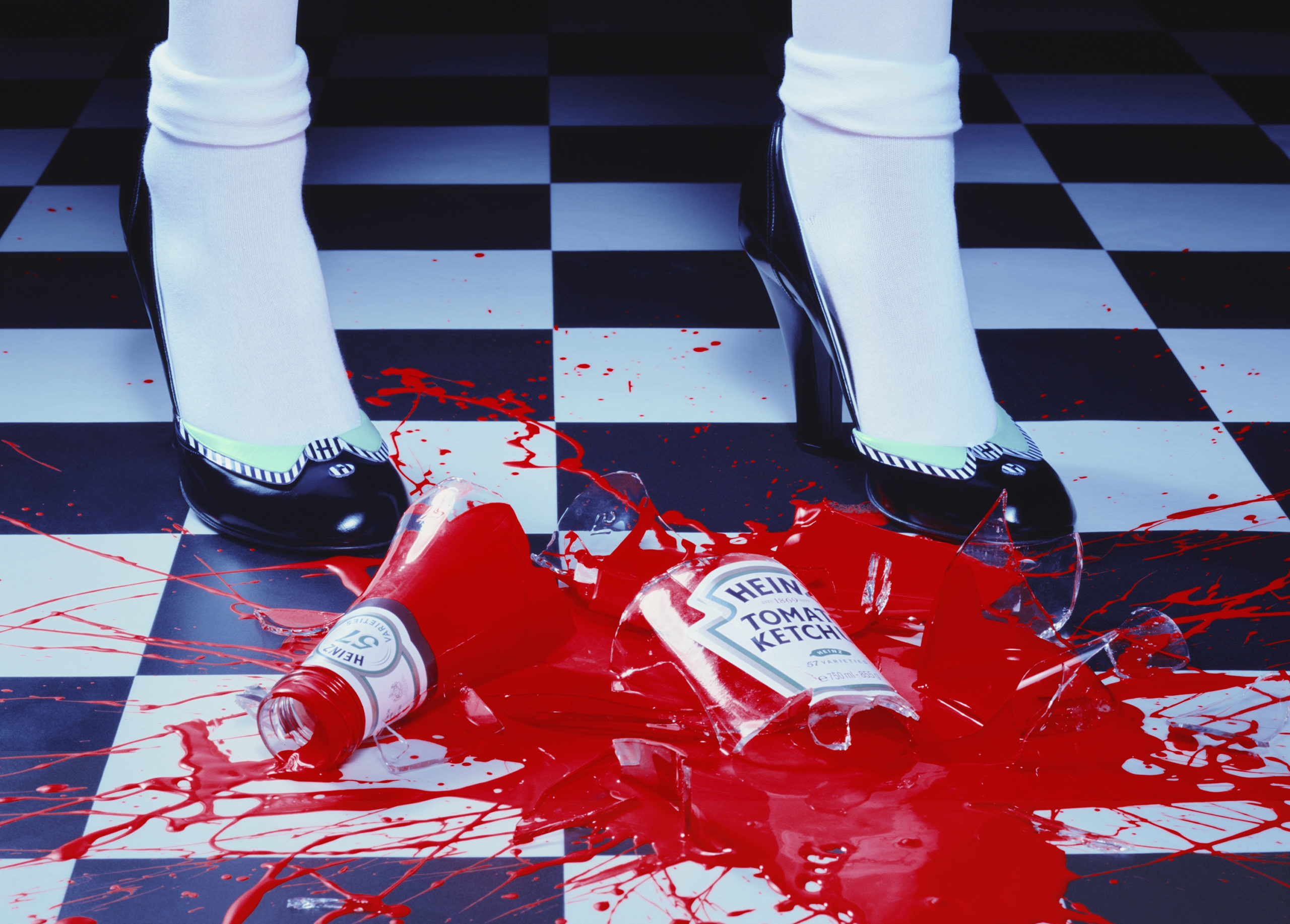Stark studio lighting, perfectly balanced compositions and immaculate female models expose Miles Aldridge’s scenes as staged. Whilst glamorous female protagonists and vivacious colour remain Aldridge’s dual obsessions, he is interested in creating an underlying sense of discomfort. Admiring Hitchcock’s ability to render the ordinary strange and sinister, Aldridge has identified his own aim as being to ‘stop the viewer from turning the page of the magazine’. The blurred lines between fashion photography, art and cinema are thus highly deliberate and play a crucial role in conjuring the disturbances achieved within his imagery.
In Aldridge’s work, each scene is highly constructed with painstaking attention to lighting, composition and colour. Giving the example of the smashed ketchup bottle in A Drop of Red #2, Aldridge states that he recreates his own experiences, giving his tableaux a sense of the surreal. His training in illustration at Central Saint Martins also remains implicit in his work – typically commencing with a series of preparatory drawings. It is thus no accident that one might consider Aldridge’s images as stills from a film where the unfolding scene is but one part of a wider story. The suggestion of a narrative beyond the frame implicates the spectator’s mind in the viewing experience by prompting them to imagine the moment before and after the present scene. The viewer is further implicated by the highly saturated colours, which serve as an invitation to indulge in Aldridge’s hyper-real environments. Referring to his expressive use of colour as a ‘trick’, Aldridge reveals his desire to render the act of viewing an act of participation. A Freudian dynamic of simultaneous attraction and repulsion is recalled in Aldridge’s work where vibrant aesthetic qualities entice the viewer into a scene which is implicitly dangerous or disconcerting.

A Drop of Red #2, 2001
A further technique deployed by Aldridge is a displacement of the ordinary. The highly stylised interiors are those of the everyday – supermarkets, kitchens, bathrooms. It is the excess of materiality, from supermarket aisles to resplendent jewellery, coupled with an absence of genuine emotion in the female models, that gives rise to a palpable unease in his works. In this way, Aldridge’s images appear as anti-statements about the consumer culture they exhibit. Specifically, the impact of Lynch’s Blue Velvet on Aldridge as an individual is apparent. The well-maintained exteriors of houses in David Lynch’s fictional neighbourhood don’t go far in upholding an illusion of perfection, and Aldridge’s work is comparable to the turmoil that goes on behind Lynch’s closed doors. In particular, Aldridge’s female protagonists recall the glamour and splendour of Isabella Rossellini’s character whilst at the same time remaining suggestive of something far more sinister. The passive expressions of the figures, and forced acknowledgement of this by Aldridge’s lens, prompt the viewer to question their own role in consumer society.
Aldridge as director, rather than photographer, is nowhere more evident than in Chromo Thriller #2. Here, the spilt wine and multiple glasses imply action and another character; moreover, the plastic-covered bed upon which the female protagonist lies serves as a premonition of what might be to come. A further sense of foreboding is achieved by the deep red wine seeping into the carpet. The viewer’s attention is quickly brought to the face of the female figure by studio lighting and the mise-en-scène: her arms and the curtains in the background framing her face. Aldridge notes that his favourite moments in Hollywood cinema are ‘the closeups of a woman’s face, thinking’. In film, the camera zooming in on a face encourages the viewer to consider the character’s contemplation. Aldridge has skilfully been able to achieve this cinematic technique in the form of a photograph. By highlighting the model’s face the viewer is able to perform the function a camera would in film. This kinetic component, with the suggestion of a progression from one frame to another, expertly blurs the distinction between photography and film
